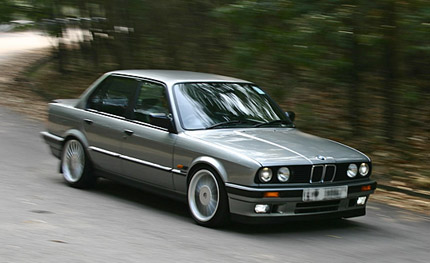 German cars are traditionally considered to be very durable and relatively reliable. So what does the everyday use of a teenage BMW 316i look like??
German cars are traditionally considered to be very durable and relatively reliable. So what does the everyday use of a teenage BMW 316i look like??
The car produced in a year 1990 and brought to Poland four years later, was bought in November 1996 years behind 20 000 zloty. The relatively high price was justified by the good technical condition of the vehicle, low mileage and reliable source of origin. At the time of purchase, the meter was showing 89 000 km, which was documented by entries in the original service book.
The first driving impressions were definitely positive. Car, although it was designed several years ago, has such a unique figure, that many people find its exterior attractive even today. Also the interior of the car, kept in perfect condition, made a very good impression. High-quality materials were used for the finishing, the adjustment of individual elements does not raise any objections either. The dashboard can serve as an example of ergonomics, which is so successful, that after minor changes it went to the E36 model produced for a year 1991.
The design of the seats is very good, providing sufficient lateral support during dynamic driving. Both are height adjustable. There is a lot of space in front, especially when two people are traveling and the seats can be moved to the rear. It is a bit worse with the places for the legs of the rear seat passengers. The trunk does not raise any major objections. Only the high loading edge makes it difficult to pack heavy items.
The car is equipped with the smallest four-cylinder unit in the company's offer. The smallest does not mean weak with BMW. The engine is powerful 100 MILES, what about the displacement 1600 ccm should be considered an achievement. Power is transferred to the rear wheels, which, depending on the point of view, can be considered a disadvantage or an advantage. On the one hand, driving in winter, especially starting on slippery surfaces may be difficult, on the other hand, however, the separation of the drive and steering systems does, that the steering is "calmer".
The large weight of the car and the low streamlined body make it, that the dynamics is not great. Accelerating to 100 km / h takes approx 12 s. The maximum speed stated by the manufacturer is 185 km/h, and the comfortable travel speed is approx 140 km/h.
Very good suspension makes, that driving fast on winding roads is a real pleasure. The operation of the braking system is also sufficiently effective in relation to the car's performance.
The operation of the car began with the replacement of the recommended timing gear 40 000 km. There was also a careful review, during which the car received new oil, brake fluid and spark plugs. A few weeks later, of course, when going outside Warsaw, the car started acting weird. The engine ran erratically, and its launch was difficult.
A visit to a BMW station confirmed the suspicion, that the cause of the trouble is an excessively worn distributor finger. At the next inspection, the brake pads were replaced, drums and one of the brake cylinders. The next few months of operation passed without any problems. In May it became necessary to use a new silencer. During the summer, the car traveled several thousand kilometers, and its operation was limited to refilling fluids. It was only in late autumn that the car needed a bit of care - new rear shock absorber cushions as well as brake discs and pads improved them one hundred percent.
The only failure during the test took place in December; in the early morning, at very low temperatures, the engine did not start. After being towed to the workshop, it turned out, that the cause of the trouble is a defective spark plug. After screwing in the new candles, the engine started immediately. By the way, it was tested by detecting damage to the lambda probe, which was replaced with a new one.
After the run 130 thousand. km the timing belt was changed again, and a broken steering cuff. It was also necessary to purchase a new fan clutch and a set of shock absorbers. At the end of the test, the car ran over 3000 kilometers in the south of Europe. Despite very high temperatures, it performed great. Very winding mountain roads with long descents provided another opportunity to test the efficiency of the braking system.
After driving over 150 thousand. km the car hit the diagnostic line. The first surprise was the very good result of the exhaust gas purity measurement. The CO content in the exhaust gas was only 0,01 proc., and hydrocarbons 15 ppm. The brakes also performed well, however it turned out, that the left rear wheel brakes less than the rest. Visual inspection showed the cause – dirty jaws. It turned out to be necessary to slightly adjust the headlights. Compression pressure in the cylinders was within the standard provided by the manufacturer for the new engine.
Though the list of these items is long, Due to careful maintenance, a fairly old car is in very good technical condition, and the comfort of traveling does not differ significantly from newer cars of this class.
Technical data
Petrol engine, inline, 4-cyl., located longitudinally at the front. OHC. Two valves per cylinder. Capacity. jumping 1596 ccm. Wed. cylinder x stroke 84,0 x 72,0 Mm. Compression ratio 9,0. Power. 74 kW (100 MILES) by 5500 obr./ min. Max. torque 141 Nm at 4250 obr./min. Five-speed gearbox. Rear-wheel drive. Independent wheel suspension. Front disc brakes, rear drum. Tires 175/70 R14. Fuel tank 55 l. Trunk 425 l. Own weight 1065 Kg. Capacity 460 Kg. Braked trailer weight 1200 Kg. Dimensions length / width / height. 4325/1645/1380 Mm